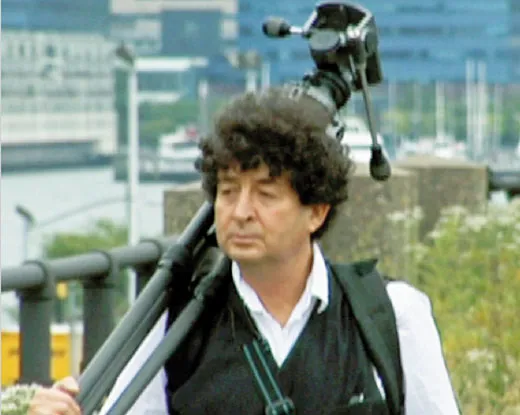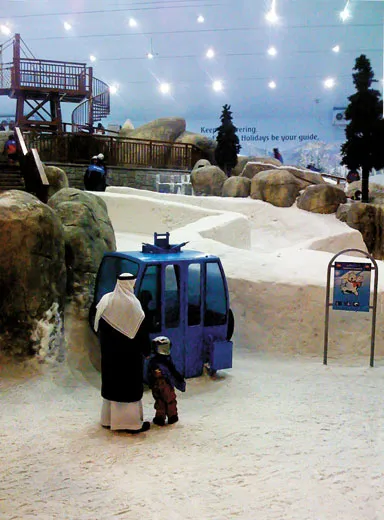Seeing Dubai Through a Cell Phone Camera
At a shopping mall in Dubai, Joel Sternfeld documents the peak of consumer culture with his iPhone
/https://tf-cmsv2-smithsonianmag-media.s3.amazonaws.com/filer/Indelible-iDubai-ski-slopes-631.jpg)
For years Joel Sternfeld roamed the country with the sort of camera that rests on a tripod and usually requires the photographer to compose each shot carefully from beneath a black drape. Beginning in the late 1980s he became known for photographs that examined how Americans related to one another and to their environment—his best-known book, American Prospects (1987), highlighted incongruities between people and places, such as a woman sunbathing with warships in the far background, or a firefighter buying a pumpkin while a house burns. But for his most recent project, he went to Dubai and took pictures in shopping malls with an iPhone.
This new direction was, in fact, a logical extension of his work. Sternfeld, who was born in 1944 in New York City, traveled to Montreal in 2005 to photograph the 11th United Nations conference on climate change; his book When It Changed documented the looks on the delegates’ faces as they absorbed data on the condition of the planet. He came away with the realization that solving climate change wasn’t enough, because the underlying forces that have led to it, especially consumerism, would continue to deplete natural resources, though perhaps in a different way. He decided to make this basic human ravenousness his latest subject, which led him to Dubai.
The emirate is home not only to an archipelago of palm-shaped man-made islands, but also to the world’s tallest building (the Burj Khalifa, 2,716 feet) and most expansive shopping-and-entertainment complex (the Dubai Mall, over 12 million square feet). A government Web site, dubaitourism.ae, touts the emirate as a “shopper’s paradise” whose “marble-walled malls and efficient air conditioning provide a cool welcome to customers.” In Dubai, Sternfeld, says, “you have one megamall right next to another megamall.”
Dubai, decided Sternfeld, was “a perfect symbolic site for a consuming world.” Where his previous subjects were understated and earthy, Dubai was dazzling and outsize; similarly, where his previous photographic style was measured and careful, the Dubai project would require a style that was casual, even impulsive—like shopping itself. Art, Sternfeld believes, is at its best when there is a unity of form and content—“When you have unity, I think it squares the reach or power of the work,” he says—so the idea of documenting consumerism with a consumer product was especially appealing. Thus the iPhone.
In his new book, iDubai, Sternfeld has published scores of these photographs: an opulent chrome sports car awaits its valet parker outside the Kempinski Hotel; a model of downtown Dubai features red “sold” flags poking from the skyscrapers. Others feature aisles of colorful packaged goods, shopping carts overflowing with toys, and tourists bent intently over their own smart phones, oblivious to the nearby stranger photographing them with his.
And yet Sternfeld says he came to feel a certain affinity. Some of the malls were “imaginative, interesting places” with a “dreamlike quality.” More important, they served a vital social role as town centers, places for friends and family to gather. And he often noticed scenes of paternal love—men eating with children at the food court, or pushing a stroller into a glass elevator, or, as on the opposite page, contemplating the wonders of an indoor ski slope—an aspect of the Arabic male he felt was underrepresented in Western media.
The photographs in iDubai are deeply ambivalent. The perversity of modernity, from Sternfeld’s point of view, is that even these moments of familial togetherness take place within a culture that is ultimately unsustainable and destructive. He has emphasized that iDubai is a criticism of globalized, and not Arab, consumerism; what he hopes for is a greater appreciation of what he sees as our shaky future.
David Zax, who lives in Brooklyn and covers technology for Fast Company, has written frequently for Smithsonian.
Planning Your Next Trip?
Explore great travel deals
Smithsonian magazine participates in affiliate link advertising programs. If you purchase an item through these links, we receive a commission.
/https://tf-cmsv2-smithsonianmag-media.s3.amazonaws.com/accounts/headshot/david-zax-240.jpg)


/https://tf-cmsv2-smithsonianmag-media.s3.amazonaws.com/accounts/headshot/david-zax-240.jpg)
